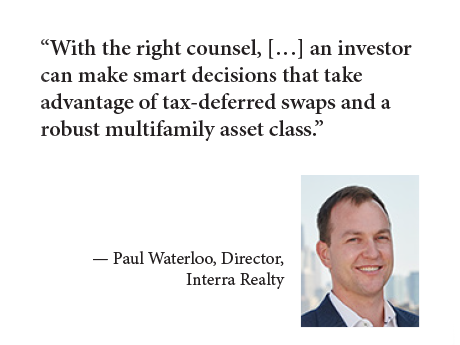1031 exchanges are an effective way for investors to protect their capital. They also historically have experienced strong fundamentals in the long term. Why, then, aren’t more multifamily investors taking advantage of tax-deferred swaps?
Many property owners simply lack the expertise and industry connections to source acquisition opportunities that meet their objectives. This is especially true considering the tight timeframe many 1031 exchanges operate under, as these types of deals have a built-in ticking clock. Once an investor sells an asset, he or she has 45 days to identify a replacement property and 180 days to close. That’s a very short window in which to secure financing and perform proper due diligence.
There remains uncertainty among some investors about 1031 exchanges, which allow an investor to defer capital gains on a property sale when those funds are used to acquire a “like kind” property. The IRS considers two assets to be like kind so long as they both are used for business purposes or held as an investment. This means investors may exit one sector and broaden their exposure to another.
With the right counsel, however, an investor can make smart decisions that take advantage of tax-deferred swaps and a robust multifamily asset class. Here are three questions every investor should ask themselves before acquiring a multifamily property through a 1031 exchange.
Are apartment buildings a good investment right now?
The marketplace continues to adjust to the rise in interest rates over the past 12 months. At its September meeting, the Federal Open Markets Committee held rates steady but indicated that one more rate hike would be announced before the end of the year.
Despite this, the multifamily industry is still experiencing strong demand. Most multifamily buyers have a long-term-hold mentality — a common thread with investors who complete 1031 exchanges — which should insulate them from any economic turbulence. Additionally, multifamily properties offer the unique ability to adjust for inflation on an annual basis, as the majority of leases have 12-month terms. This provides an effective hedge against an inflationary marketplace such as the one we are currently experiencing.
The apartment sector remains a stable harbor for capital in any economic climate. According to the National Multifamily Housing Council’s latest Quarterly Survey of Apartment Market Conditions, senior executives of apartment-related firms see positive movement in the sector. Over the past three to six months, respondents stated that their local markets have grown tighter, with lower vacancies and higher rents.
Can I use a 1031 exchange to diversify my portfolio?
One great benefit to tax-deferred swaps is that they give investors the latitude to change markets or sectors, in addition to growing their portfolio. Over the past few years, Interra Realty has seen a fair amount of movement from troubled asset classes — such as retail and office — to sectors with stronger fundamentals, including multifamily.
Interra recently brokered such a deal. Our firm’s client took the proceeds from the sale of a retail property and used them for the $17.1 million acquisition of 828 Lofts, a 44-unit residential asset near Northwestern University in Evanston, Illinois. The client was attracted to the community because it was fully occupied, allowing for a steady revenue stream over a long ownership period.
That said, the more common scenario is for investors to sell one apartment community and acquire another. Tax-deferred swaps are an excellent way for investors to expand their unit count, especially when the proceeds of the initial sale are paired with additional debt or equity. Last year, Interra worked with a client that sold a four-unit property in Evanston. The client used an off-market 29-unit property in Melrose Park, Illinois, to fulfill their 1031 exchange. The exchange greatly increased their unit count and overall cash flow.
Investors can also use 1031 exchanges to shift their capital from one market or submarket to another. This could be to tap into stronger demand or population growth in an area, but the factors can be personal rather than market-based. One Interra client sold a sizable portfolio on Chicago’s South Side and rolled the proceeds over into a purchase in Norwood Park, on the city’s far northwest side. The property in Norwood Park was chosen simply because it was closer to the owner’s home, and thus easier to manage.
How do I find a replacement property in time?
Once they close the sale of their relinquished property, an investor has 45 days to identify a replacement. The IRS requires that identification to be unambiguous, with a written report of the property including address and description.
Investors should engage with their broker as soon as possible to guarantee that they will locate a property that fits their criteria — such as location, size, condition — before time runs out. Of course, the scouting process for a replacement can begin before the closing of the relinquished property, which provides a bit of leeway.
The 1031 exchange platform is one of the best tax programs available to real estate investors. While they can be difficult to execute, expert guidance from knowledgeable partners can lead to profitable results. This is especially true for multifamily assets, which have proven to perform well in the long run.
Paul Waterloo is a director with Chicago-based Interra Realty, a multifamily brokerage that specializes in middle-market assets.


